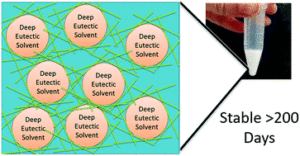We are very pleased to introduce Karen Edler and Saffron Bryant, corresponding authors of the paper ‘Deep eutectic solvent in water pickering emulsions stabilised by cellulose nanofibrils‘. Their article has been very well received and handpicked by our reviewers and handling editors as one of our October HOT articles. Karen and Saffron told us more about the work that went into this article and what they hope to achieve in the future. You can find out more about the authors and their article below and find more HOT articles in our online collection.
Meet the authors
Prof Karen Edler is Professor of Soft Matter at the University of Bath and has a long standing interest in understanding how self-assembly and molecular scale interactions in solutions affect the properties of emulsions, gels, nano/microparticles and mesoporous materials.
Dr Saffron Bryant is currently a research fellow at RMIT University with a keen interest in using ionic liquids and deep eutectic solvents for practical-based applications.
Could you briefly explain the focus of your article to the non-specialist (in one or two sentences only) and why it is of current interest?
Deep eutectic solvents (DES) are relatively novel liquids which are made up of (normally) two molecules that are usually solid, but when they interact together become liquids, which can have tuneable properties depending on the two molecules you choose. This means they can be selected to dissolve a wide range of species (drugs, dyes, nutrients, metal species, polymers etc) without water, or toxic organic solvents and are currently finding applications in many fields from drug delivery to functional materials synthesis. Some researchers suggest DES could even form naturally inside plant cells to help them avoid freezing or drying out. Making use of them in Pickering emulsions is interesting as a potential component in cosmetics, therapeutics or foods, where they could help deliver poorly water soluble species and also, for instance, enhance penetration through the skin for topical anaesthetics. We have been working on functionalised cellulose nanofibrils in emulsions and gels as part of the consortium Gelenz, funded by the EPSRC alongside our partners in the Universities of Bristol, Manchester and UEA and colleagues in industry.
How big an impact could your results potentially have?
Pickering emulsions are interesting as they can be highly stable and do not require use of surfactants which can be irritants or toxic to aquatic life. Demonstrating the formation of Pickering emulsions using sustainable cellulose particles as a stabiliser for an emulsion, where the “oil” components are also bio-derived molecules, shows the potential of these systems in more sustainable, less environmentally harmful formulations which could be replacements for products people use in large quantities every day such as creams and lotions. This would have obvious benefits in reducing harm to our water systems and the environment.
Could you explain the motivation behind this study?
We are interested in finding more sustainable replacements for personal care formulations, and in making them more useful for a wider range of applications, so we wanted to scope the potential for using DES in cellulose nanofibril stabilised emulsions.
In your opinion, what are the key design considerations for your study?
The key parameters here are the aspect ratio of the cellulose particles, and their surface functionalisation, as well as choice of a suitable DES for encapsulation.
Which part of the work towards this paper proved to be most challenging?
The most challenging aspect of this work was identifying a suitable deep eutectic solvent that didn’t interact with the cellulose and disrupt the emulsion.
What aspect of your work are you most excited about at the moment?
We are most excited about the opportunity for extensive variations on this work using sustainably sourced components. For example, by using different hydrophobic deep eutectic solvents for different properties, or altering the properties of the cellulose stabiliser to give more functionality to the emulsion. The potential applications of these systems are endless.
What is the next step? What work is planned?
We are continuing to investigate environmentally friendly rheology modifiers and emulsifiers in a range of systems, and we are working to understand self-assembly and colloidal organisation in these novel deep eutectic solvents, to be able to predict how to choose components of these interesting liquids to achieve particular tasks eg dissolve a particular molecule, or mix (or not mix) in a complex solution with other species.
Deep eutectic solvent in water pickering emulsions stabilised by cellulose nanofibrils
Saffron J. Bryant, Marcelo A. da Silva, Kazi M. Zakir Hossain, Vincenzo Calabrese, Janet L. Scott and Karen J. Edler
RSC Adv., 2020,10, 37023-37027
DOI: 10.1039/D0RA07575B, Paper
 Submit to RSC Advances today! Check out our author guidelines for information on our article types or find out more about the advantages of publishing in a Royal Society of Chemistry journal.
Submit to RSC Advances today! Check out our author guidelines for information on our article types or find out more about the advantages of publishing in a Royal Society of Chemistry journal.
Keep up to date with our latest HOT articles, Reviews, Collections & more by following us on Twitter. You can also keep informed by signing up to our E-Alerts.












